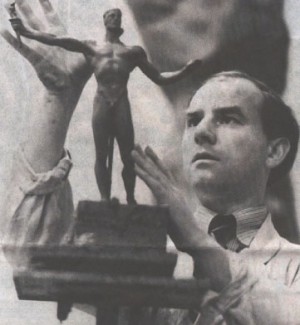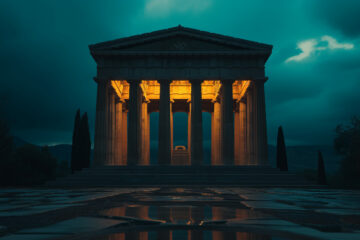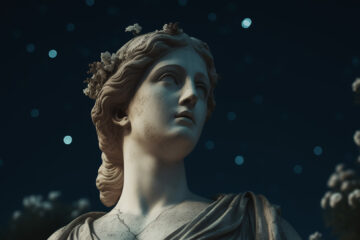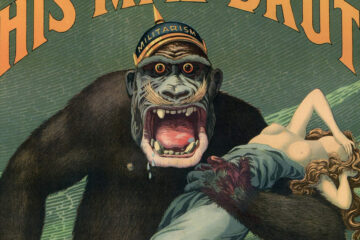The Guardian of the Image of Man
 by B. John Zavrel
by B. John Zavrel
Originally published in: Arno Breker: Divine Beauty in Art
“Who in all his work sees God,
He in truth goes unto God:
God is his worship, God is his offering,
Offered by God in the fire of God:”
— The Bhagavad Gita
THOUGHTS FLY OFTEN back to that memorable evening when I first met Arno Breker. The long flight across the Atlantic from America back to Europe, the land of my forefathers, brings me to Breker’s home near the airport in Düsseldorf. As we drive up the long driveway to the house, his Prometheus — the god who brought culture and the divine fire to mankind — greets us with his blazing torch. Like the Prometheus of old, so has Arno Breker brought us fire and light, and then had to relive the suffering of Prometheus. What a miracle that this troubled world of our space age, with its countless wars, revolutions, upheavals, and catastrophes, has failed to discourage Breker from his calling and from his belief in the goodness of mankind and its future!
The events leading up to our meeting race through my mind as we approach the master’s home in silence: Not long ago, the American President Ronald Reagan declared 1983 the year of the 300th Anniversary of German immigration to America, and this resulted in the founding of the Arno Breker Society, International, in the United States, with myself as its first president. The main goal of this cultural society, which was founded in cooperation with such artists as Dali, Peyrefitte, Fuchs, Mourlot, and many others, is to support the cooperation between Europe and America, between Germany and the United States in the fields of art and science for friendship, mutual respect, and better understanding. On this occasion a portfolio, Salute America, was published with texts by Ronald Reagan, Helmut Kohl, George Bush, and Karl Carstens, and a set of original lithographs created by Arno Breker, as a gesture of their continuing support of the ideals of friendship, freedom, and justice.
“I was afraid I would not get to meet you” were the first words of the frail artist, who was recovering after a recent implant of a heart pacemaker, as we embraced. His warm and sincere welcome and the hospitality of his wife Charlotte made my initial anxiety quickly disappear He was moved and delighted by the gifts which I brought him from his friends in America-a few handfuls of American soil and an Indian chief’s war bonnet, which was made especially for him by a full-blooded Sioux Indian. We talked about his art and life, about his ideas and his plans for the future. He remembered his artist friends and his models. Many of his famous portrait-busts surrounded us as we talked in his atelier:
There were Konrad Adenauer; Ludwig Erhard, Salvador Dali, Gerhart Hauptmann, Ezra Pound, Ernst Jünger, and Roger Peyrefitte, as well as Alexander the Great and Richard Wagner. Time and again Breker had encountered both well-known and unknown people whose nature and bearing fascinated him and whom he considered worthy of being immortalized in bronze. In answering my question as to what all these people had in common, as seen by the artist, Breker replied: “My experience in creating portraits has for the most part confirmed again and again that real human greatness and reputation go hand in hand with ability, humility, preparedness to serve, modesty, preparedness for sacrifice, diligence, and faith in the future.”…
And thus, with each of his new creations, Arno Breker continues to speak to us silently, without words. Yet his language strikes deep into the soul and awakens it to recognition of infinite harmony. Viewing his model-a man or a woman-Breker transcends it to find its image in the realm of spiritual interpretation. In portraying what is visible, he captures the essence of that which is real and eternal and which heralds the values of the Higher Man. Never content to limit his work to reproducing only that which the physical eye beholds, Breker infuses into his creations something of the eternal principles toward which man aspires.
“I am the sculptor of the human body, in its perfect harmony of the triad of the body, spirit, and soul,” runs the creed of Breker. This man, who is both as old and as young as this century, has never tired of glorifying the image of man. And thus his virtues of loyalty, honor, perseverance, and faith have singled out Arno Breker from among the sculptors of the 20th century as its true “Guardian of the Image of Man.”
Read the full article at the Museum of European Art





